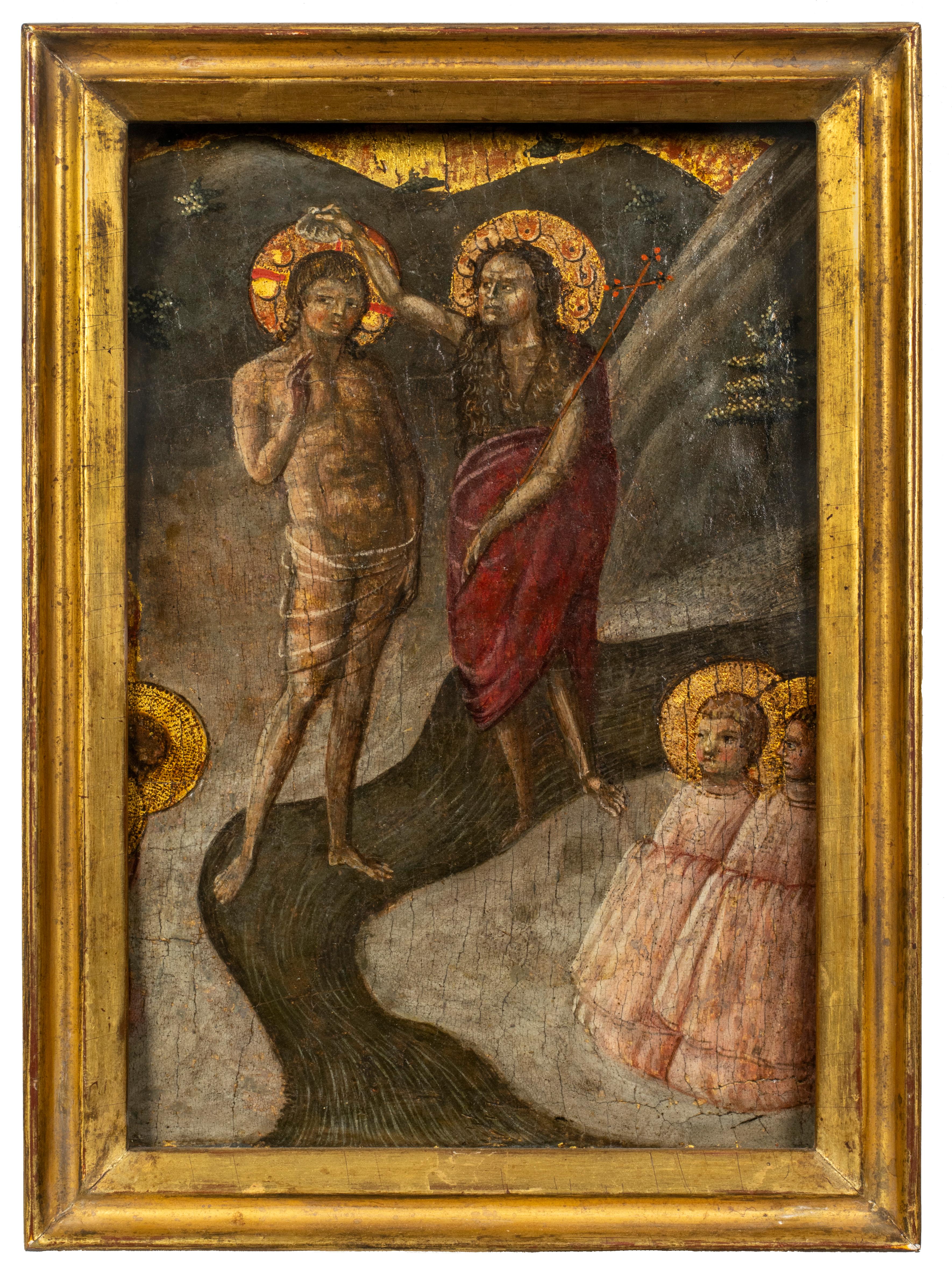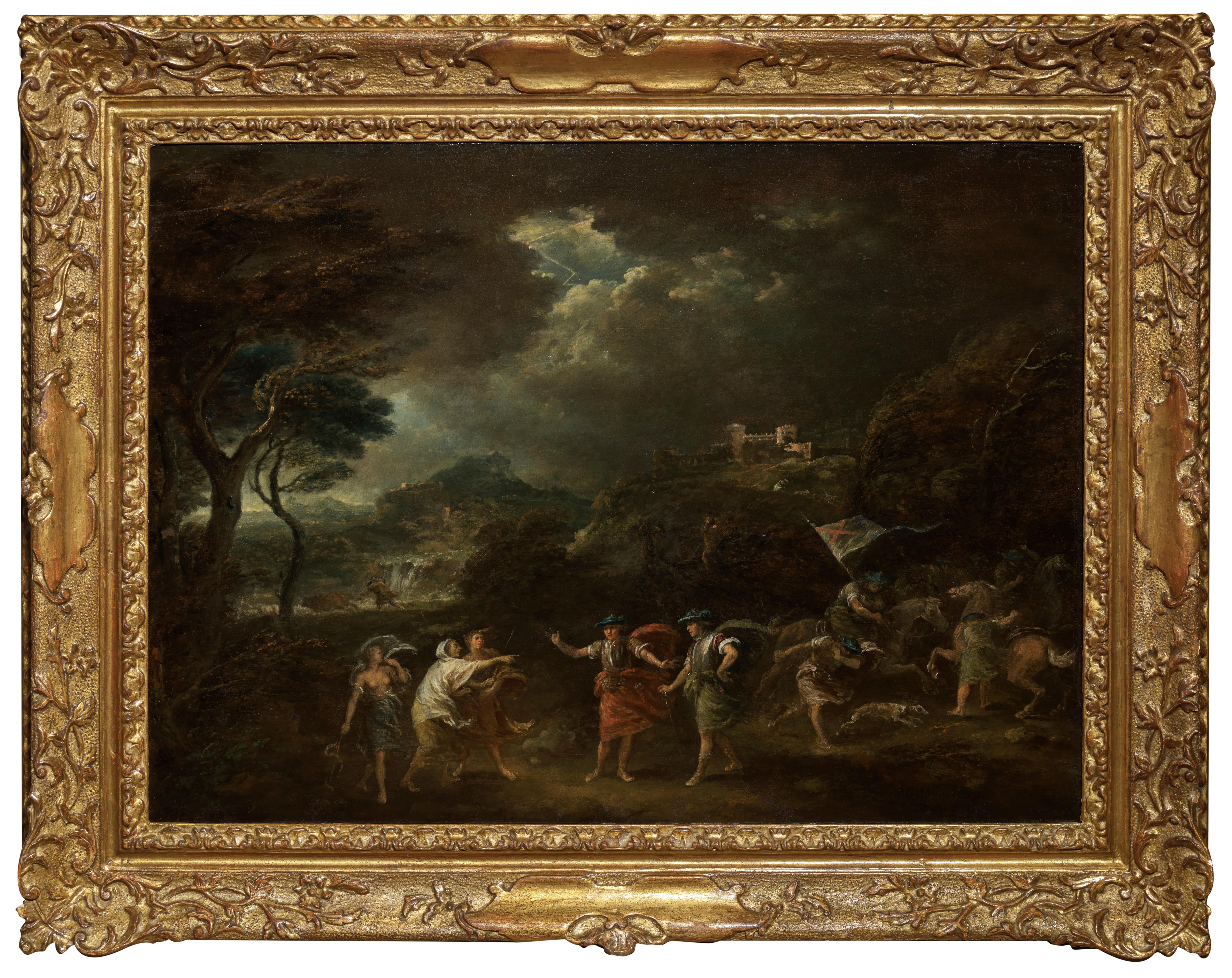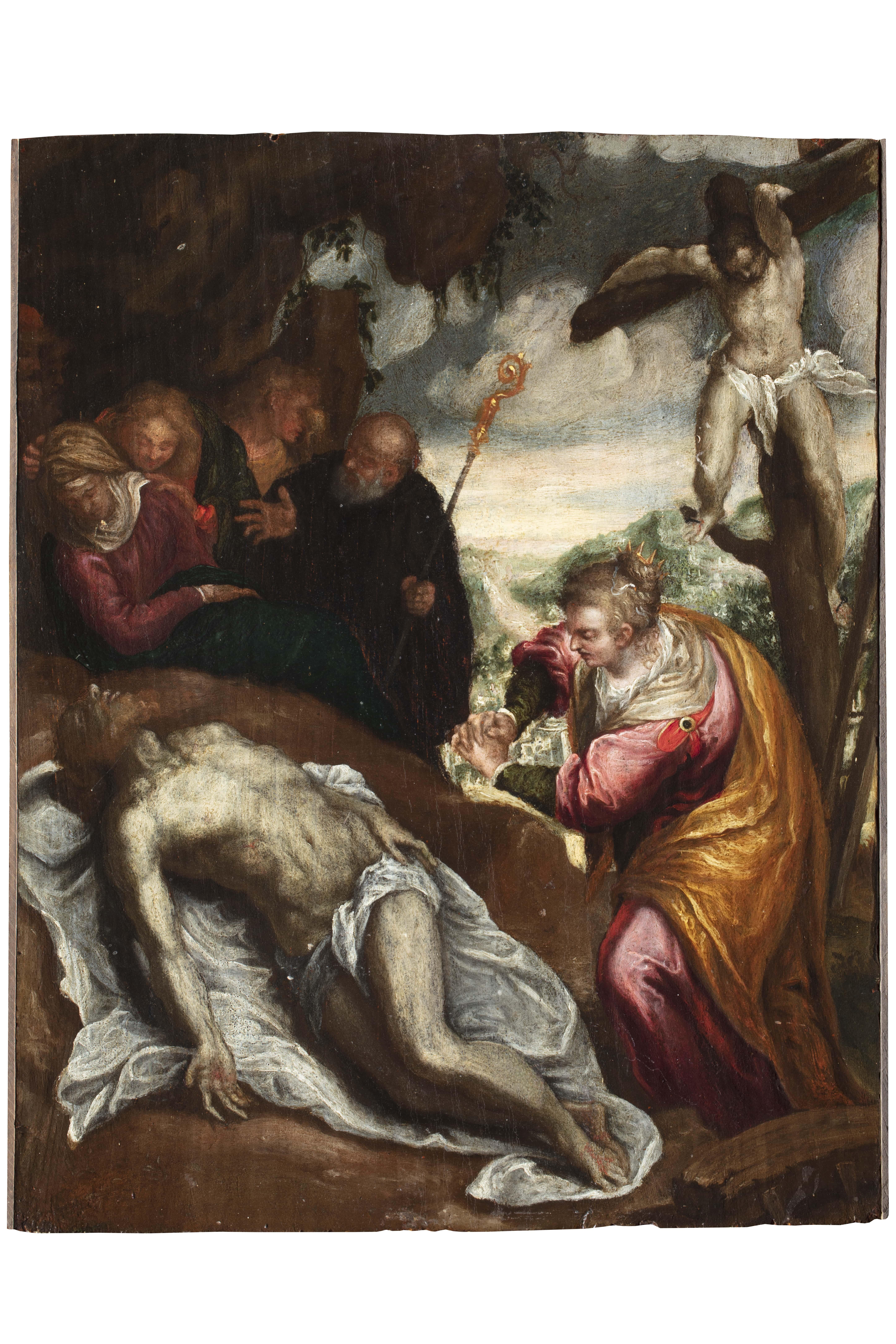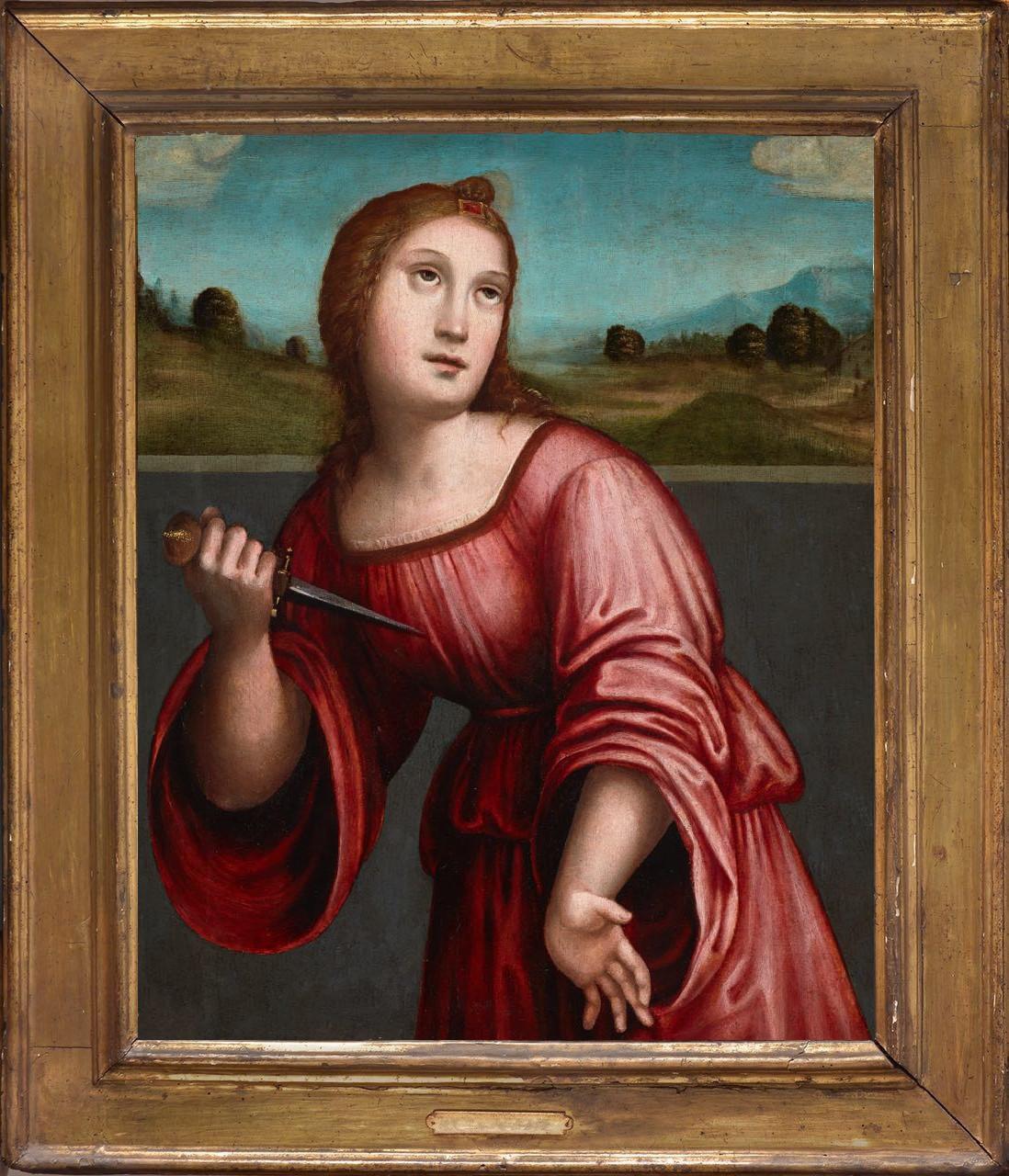Items Similar to Circa 1400, Spanish school of 'The Prophet Daniel', tempera on panel with gildin
Want more images or videos?
Request additional images or videos from the seller
UnknownCirca 1400, Spanish school of 'The Prophet Daniel', tempera on panel with gildin
About the Item
Spanish school, circa 1400
The prophet Daniel
Tempera on panel with gilding
35.1/4 x 10.5/8 in. (89.5 x 28 cm.)
Condition: The painting has been recently stabilised and cleaned up. There are missing pieces of the composition, It was decided not to infill these to retain an authentic integrity. The painting has cracked and there are chips. The gilding is faded and rubbed and there is possible earlier overpainting but overall it is a fine and very early work. There has been doubt regarding whether this is Spanish or Italian and we are investigating the coat of arms at the top of the composition. The panel has incised carved elements and it is possible it has come from a place of worship.
- Dimensions:Height: 35.25 in (89.54 cm)Width: 10.63 in (27.01 cm)Depth: 1 in (2.54 cm)
- Medium:
- Movement & Style:
- Period:
- Condition:The painting has been recently stabilised and cleaned up. There are missing pieces of the composition, It was decided not to infill these to retain an authentic integrity. The painting has cracked and there are chips.
- Gallery Location:Petworth, GB
- Reference Number:1stDibs: LU54039091332
About the Seller
4.9
Platinum Seller
These expertly vetted sellers are 1stDibs' most experienced sellers and are rated highest by our customers.
Established in 2010
1stDibs seller since 2017
229 sales on 1stDibs
Typical response time: 2 hours
- ShippingRetrieving quote...Ships From: Petworth, United Kingdom
- Return PolicyA return for this item may be initiated within 10 days of delivery.
More From This SellerView All
- British, 20th Century surrealist painting of lunchtime on the lake, 1986Located in Petworth, West SussexRonnie Copas (British, b.1936) Lunchtime on the Lake, 1986 egg tempera on panel signed and dated ‘Copas 86’ (lower left) 26.3 x 31.3 cm. Born in London, ...Category
20th Century Surrealist Figurative Paintings
MaterialsEgg Tempera, Panel
- Art Deco British symbolist painting 'Triune' by Robert Arthur WilsonBy Robert Arthur WilsonLocated in Petworth, West SussexThis artwork is a captivating representation of The Trinity, created by the British artist Robert Arthur Wilson. It vividly demonstrates Wilson's profound engagement with avant-garde theories related to colour, music, and emotion, which had a significant impact on his artistic vision. Wilson's exploration of colour abstraction was groundbreaking and played a pivotal role in establishing him as one of the most promising artists of his time. His innovative approach to colour abstraction is evident not only in the portrayal of the sky but also in the overall composition of this piece. Robert Arthur Wilson (British, 1884 – 1979) Triune Tempera on panel Signed ‘R.A. Wilson’ (lower right) and titled on a label on the reverse 29.1/8 x 29.1/8 in. (69 x 69 in. ) Robert Arthur Wilson was a British painter. Wilson was born in Sunderland in 1884. Leaving school at the age of thirteen, he was employed for a time as a bookkeeper before beginning an apprenticeship under a local sign...Category
20th Century Symbolist Figurative Paintings
MaterialsPanel, Tempera
- Italian, 17th Century old master oil painting of the AnnunciationBy Giovanni Francesco Barbieri (Il Guercino)Located in Petworth, West SussexCircle of Giovanni Francesco Barbieri, called Guercino (Italian, 1591 – 1666) An annunciation Oil on canvas 30 x 45 in. (76.2 x 114.4 cm.)Category
17th Century Old Masters Figurative Paintings
MaterialsOil, Canvas
- Turn of the 20th Century French tryptic depicting the Annunciation with 2 saintsLocated in Petworth, West SussexA. Lion (French, c. 1900) A tryptic depicting the Annunciation flanked by two Saints Signed “A. LION” (to the left of Mary) Oil on board Framed dimensions 23. ½ x 37. ½ in. (60 x 95...Category
19th Century Old Masters Figurative Paintings
MaterialsBoard, Oil
- French 18th Century Old Master oil painting of a soldier departing from his homeLocated in Petworth, West SussexCircle of Jean-Baptiste Francois Pater (French, 1695-1736) Le depart du convoie Oil on canvas 36.1/2 x 39.3/4 in. (92.8 x 101 cm.)Category
18th Century Old Masters Figurative Paintings
MaterialsOil, Canvas
- French Old Master oil painting of 3 figures releasing a doveBy Jean-Antoine WatteauLocated in Petworth, West SussexCircle of Jean-Antoine Watteau (French, 1684-1721) Freeing a dove Oil on canvas 27.3/4 x 38.1/8 in. (70 x 96.8 cm.) Possible repair to upper right. In overall good order for the age...Category
17th Century Old Masters Figurative Paintings
MaterialsOil, Canvas
You May Also Like
- Baptism of ChristLocated in New York, NYProvenance: Achillito Chiesa, Milan Luigi Albrighi, Florence, by 1 July 1955 with Marcello and Carlo Sestieri, Rome, 1969 Private Collection, Connecticut Exhibited: Mount Holyoke College Art Museum, South Hadley, Massachusetts (on loan, 2012) Literature: Carlo Volpe, “Alcune restituzioni al Maestro dei Santi Quirico e Giulitta,” in Quaderni di Emblema 2: Miscellanea di Bonsanti, Fahy, Francisci, Gardner, Mortari, Sestieri, Volpe, Zeri, Bergamo, 1973, pp. 19-20, fig. 18, as by the Master of Saints Quiricus and Julitta (now identified as Borghese di Piero). This fine predella panel depicting the Baptism...Category
15th Century and Earlier Old Masters Figurative Paintings
MaterialsWood Panel, Tempera
- Russian Icon 16th century The Battle of the Novogorodians with the SuzdaliansBy Russian SchoolLocated in London, GBThe Battle of the Novogorodians with the Suzdalians 16th century Size 50.5 x 47.5 x 3 cm. The icon is located in the Russian Federation. There is an expert opinion from leading R...Category
16th Century Old Masters Paintings
MaterialsWood, Egg Tempera, Wood Panel
- The Resurrection of ChristLocated in New York, NYProvenance: with “Mr. Scheer,” Vienna, by July 1918; where acquired by: Jindřich Waldes, Prague, 1918–1941; thence by descent to: Private Collection, New York Literature: Rudolf Kuchynka, “České obrazy tabulové ve Waldesově obrazárně,” Památky archeologické, vol. 31 (1919), pp. 62-64, fig. 5. Jaroslav Pešina, “K datování deskových obrazů ve Waldesově obrazárně,” Ročenka Kruhu pro Pěstování Dějin Umění: za rok (1934), pp. 131-137. Jaroslav Pešina, Pozdně gotické deskové malířství v Čechách, Prague, 1940, pp. 150-151, 220. Patrik Šimon, Jindřich Waldes: sběratel umění, Prague, 2001, pp. 166, 168, footnote 190. Ivo Hlobil, “Tři gotické obrazy ze sbírky Jindřicha Waldese,” Umění, vol. 52, no. 4 (2004), p. 369. Executed sometime in the 1380s or 1390s by a close associate of the Master of the Třeboň Altarpiece, this impressive panel is a rare work created at the royal court in Prague and a significant re-discovery for the corpus of early Bohemian painting. It has emerged from an American collection, descendants of the celebrated Czech industrialist and collector Jindřich Waldes, who died in Havana fleeing Nazi-occupied Europe. The distinctive visual tradition of the Bohemian school first began to take shape in the middle of the fourteenth century after Charles IV—King of Bohemia and later Holy Roman Emperor—established Prague as a major artistic center. The influx of foreign artists and the importation of significant works of art from across Europe had a profound influence on the development of a local pictorial style. Early Italian paintings, especially those by Sienese painters and Tommaso da Modena (who worked at Charles IV’s court), had a considerable impact on the first generation of Bohemian painters. Although this influence is still felt in the brilliant gold ground and the delicate tooling of the present work, the author of this painting appears to be responding more to the paintings of his predecessors in Prague than to foreign influences. This Resurrection of Christ employs a compositional format that was popular throughout the late medieval period but was particularly pervasive in Bohemian painting. Christ is shown sitting atop a pink marble sarcophagus, stepping down onto the ground with one bare foot. He blesses the viewer with his right hand, while in his left he holds a triumphal cross with a fluttering banner, symbolizing his victory over death. Several Roman soldiers doze at the base of the tomb, except for one grotesque figure, who, beginning to wake, shields his eyes from the light and looks on with a face of bewilderment as Christ emerges from his tomb. Christ is wrapped in a striking red robe with a blue interior lining, the colors of which vary subtly in the changing light. He stands out prominently against the gold backdrop, which is interrupted only by the abstractly rendered landscape and trees on either side of him. The soldiers’ armor is rendered in exacting detail, the cool gray of the metal contrasting with the earth tones of the outer garments. The sleeping soldier set within a jumble of armor with neither face nor hands exposed, is covered with what appears to be a shield emblazoned with two flies on a white field, somewhat resembling a cartouche (Fig. 1). This may be a heraldic device of the altarpiece’s patron or it may signify evil, referencing either the Roman soldiers or death, over both of which Christ triumphs. This painting formed part of the collection assembled by the Czech industrialist and founder of the Waldes Koh-i-noor Company, Jindřich Waldes, in the early twentieth century. As a collector he is best remembered for establishing the Waldes Museum in Prague to house his collection of buttons (totaling nearly 70,000 items), as well as for being the primary patron of the modernist painter František Kupka. Waldes was also an avid collector of older art, and he approached his collecting activity with the goal of creating an encyclopedic collection of Czech art from the medieval period through to the then-present day. At the conclusion of two decades of collecting, his inventory counted 2331 paintings and drawings, 4764 prints, and 162 sculptures. This collection, which constituted the Waldesova Obrazárna (Waldes Picture Gallery), was first displayed in Waldes’ home in Prague at 44 Americká Street and later at his newly built Villa Marie at 12 Koperníkova Street. This Resurrection of Christ retains its frame from the Waldes Picture Gallery, including its original plaque “173 / Česky malíř z konce 14 stol.” (“Czech painter from the end of the 14th century”) and Waldes’ collection label on the reverse. The Resurrection of Christ was one of the most significant late medieval panel...Category
15th Century and Earlier Old Masters Paintings
MaterialsTempera, Panel
- Macbeth and the Three Witches a Painting on Panel by Francesco ZuccarelliBy Francesco ZuccarelliLocated in PARIS, FRThis painting, created during Zuccarelli's stay in England, represents the decisive moment when Macbeth, together with Banquo, meets the three witches who announce that he will be Ki...Category
1760s Old Masters Landscape Paintings
MaterialsOil, Wood Panel
- 16th Century by Venetian Maestro Deposition of Christ Oil on PanelLocated in Milano, LombardiaFormerly Canesso Collection, Paris. Publications: Bozzetti, modelletti, sketches: dalla collezione di Giorgio Baratti (From the Giorgio Baratti Collection) curated by Anna Orlando, ...Category
16th Century Old Masters Figurative Paintings
MaterialsOil, Wood Panel
- Lucretia, by Giacomo Raibolini Francia. Detto il Francia. Oil on panel, framedLocated in Brooklyn, NYGiacomo used to paint with his brother Giulio, identifying their works with the monogram «I I». The strong influence of his father, Francesco, is undeniable in all his works, althoug...Category
16th Century Old Masters Figurative Paintings
MaterialsOil, Wood Panel




